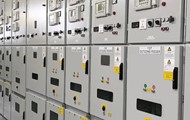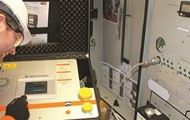Hipot Testing Services for Switchgear in Australia
Hipot Testing: Essential for Assessing Dielectric Strength and Insulation Integrity
A Hipot test, or high potential test, is crucial in evaluating the dielectric strength of electrical insulation within a device under test. This test, also known as a voltage withstand test, involves applying high voltage to a device to ensure that the insulation adequately withstands voltage transients, safeguarding against marginal insulation performance.
Hipot testing is commonly employed alongside Insulation Resistance (IR) testing during commissioning phases. It identifies major defects in the insulation system, such as inadequate creepage or clearance that could have occurred during the device's manufacturing or installation process. This testing is vital to confirm the electrical safety and operating voltage capabilities of the device, ensuring that it meets required standards and specifications.

Detecting and Locating Defects Through Hipot Testing
While hipot testing excels at detecting significant insulation issues, it is paired with Offline Partial Discharge (PD) measurements for a comprehensive assessment. These PD measurements are conducted using a 50Hz power supply, focusing on identifying smaller, more subtle defects in switchgear.
Offline Partial Discharge Measurement at 50Hz
Offline testing for PD is performed using a 50Hz external power supply, coupling capacitor and detecting equipment. We carry out this testing as part of commissioning acceptance or investigation tests in line with the Australian Standard AS 60270 (IEC 60270).
This testing is typically undertaken on busbars and circuit breakers or individual components when tracking down internal sources of PD detected using online techniques. It is a much more accurate and sensitive test than withstand testing.
For comprehensive circuit breaker testing services, explore our specialized solutions to ensure your system's safety and performance.
Testing with a 50Hz power supply (high voltage but low power) means that cables and voltage transformers are generally disconnected during test due to their inherent capacitance. Testing long busbars or switchgear with cables connected will be done using a VLF power supply.
Very Low Frequency (VLF) Testing
VLF testing can be more advantageous compared to hipot and offline PD testing of extensive cable systems due to the minimal power required—500 to 5000 times less than a standard 50Hz supply (ranging from 0.1 to 1Hz). This method enhances the practicality of testing, making it a preferred approach for comprehensive diagnostic assessments.
Get Started with Expert Hipot and VLF Testing Services
Are you ready to enhance the electrical safety and integrity of your systems with professional Hipot testing? EA Technology offers expert services to conduct Hipot and VLF Testing.
Benefits of On-site Hipot Testing for Australian Electrical Assets
- Improved accuracy in defect detection for switchgear and busbars • Compliance with Australian and international standards (AS 60270, IEC 60270)
• Preventive identification of insulation faults during commissioning
• Enhanced system safety and operational reliability
• Supports safe integration of new or refurbished electrical assets
Get Started with Expert Hipot and VLF Testing Services
Are you ready to enhance the electrical safety and integrity of your systems with professional Hipot testing? EA Technology Australia offers expert services to conduct Hipot and VLF Testing.
Contact us today to ensure your electrical assets are compliant, safe, and efficient.
Frequently Asked Questions (FAQ)
What is the test voltage for MV switchgear in Australia?
Test voltages for medium-voltage (MV) switchgear vary depending on the equipment class and standards, but typically range between 22kV and 36kV during AC Hipot testing. Always refer to AS/NZS 3000 and manufacturer recommendations.
How often should Hipot testing be performed?
Hipot testing is usually performed during commissioning, after major maintenance, or when there’s suspected insulation degradation. For high-reliability environments, periodic testing every 3–5 years is recommended.
What Australian standards apply to Hipot testing?
Relevant standards include AS/NZS 3000 (Wiring Rules), AS 60270 (for PD testing), and IEC 61010 for safety. Compliance ensures testing is both effective and safe.
Related Services

Infrared Thermographic Surveys
Have one of our electrical engineers perform an infrared thermographic survey to determine problem areas in your electrical system...

Circuit Breaker Testing
Circuit breaker testing is valuable to check the performance of individual switching mechanisms and the timing of the overall trip...

SF6 Insulation Assessment
Having issues with switchgear? SF6 gas testing checks for impurities and issues to help prevent failure.
